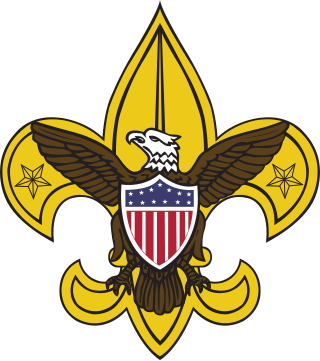
Studio 2B was a level of Girl Scouting in the Girl Scouts of the USA and consisted of girls between the ages of 11 through 17. GSUSA created the program to attract older girls into the scouting program and replace Cadette and Senior Girl Scouting.

Studio 2B was a level of Girl Scouting in the Girl Scouts of the USA and consisted of girls between the ages of 11 through 17. GSUSA created the program to attract older girls into the scouting program and replace Cadette and Senior Girl Scouting.
Studio 2B was created as a response to a lack of interest in Girl Scouting in the United States of America. A study named Ten Emerging Truths: New Directions for Girls 11-17 was conducted by the Girl Scout Research Institute (GSRI) and targeted teenaged girls both in and outside of the GSUSA program, volunteers in the program, and the families of the girls. [1] The study found that girls in the 11 through 17 age group wanted to discuss topics that were of interest to them, chose their own activities to participate in, create and be a part of their own program, and be advised by adults they can relate to. Similar studies by the GSRI concluded that nearly a quarter of the girls surveyed had less than three adults they could go to for help. [1] The Girls Scouts of the United States of America developed Studio 2B in October 2002 as a solution to the lack of adult mentors for the young women. [1] The Studio 2B system was totally phased out in 2011.
Studio 2B is the largest structural change to GSUSA since the early 1960s. It is based on a concept called the Four B's standing for Become, Belong, Believe, and Build. [1] Activities are organized using a By Girls, For Girls approach. [2] This encourages girls to take charge of the program of activities and make as many of the decisions and arrangements themselves as possible. In supplementing the book of Interest Project Patches, which are similar to Boy Scout merit badges, Studio 2B has Focus Books full of activities that the girls can choose from to earn a charm for their bracelet, or a small slide for their uniform. Like all other Girl Scouts, Studio 2B Scouts pay membership dues and live by the Girl Scout Law and Promise.
Studio 2B is designed to cater to individual needs and give girls a positive place to express themselves with help from "mentors" or "advisers", who are generally 18 to 29 years of age. Meetings are optional, and girls can scout independently if they do not join a troop.
Studio 2B differs from many other Scouting programs because of the absence of the patrol system of organization. Instead, girls are encouraged to form small temporary groups around a common interest, within their Studio 2B troop.
Focus Books were the Studio 2B equivalent to the Girl Scout Senior and Cadette Interest Project Book. They contained similar activities needed to complete an Interest Project. The Scout could earn a charm for the Studio 2B charm bracelet or slide for the uniform in lieu of a badge. Girls earned awards by meeting goals tailored to their own interests and abilities.
The Silver Award is the second highest award of the Girl Scouts of the USA. Studio 2B participants between sixth and ninth grades, or aged 11 through 14, could work on the award, but it could only be completed by girls in the seventh through ninth grades, or aged 12 through 14. After earning a series of awards to build her skills, a girl could embark on a project to benefit her community. [3] The prerequisites were changed when the Studio 2B system was phased out in 2011.
The Gold Award is the highest award of the Girl Scouts of the USA. Studio 2B participants could work on the Gold Award once they were 15 years old or joined tenth grade. The prerequisites were changed when the Studio 2B system was phased out in 2011.

A Scout is a child, usually 10–18 years of age, participating in the worldwide Scouting movement. Because of the large age and development span, many Scouting associations have split this age group into a junior and a senior section. Scouts are organized into troops averaging 20–30 Scouts under the guidance of one or more Scout Leaders or Scoutmasters. Troops subdivide into patrols of about 6–8 Scouts and engage in outdoor and special interest activities. Troops may affiliate with local, national, and international organizations. Some national Scouting associations have special interest programs such as Air Scouts, Sea Scouts, outdoor high adventure, Scouting bands, and rider Scouts.

Advancement and recognition in the Boy Scouts of America is a tradition dating from the inception of the Scouting movement. A fundamental purpose of advancement is the self-confidence a young man or woman acquires from his participation in Scouting. Advancement is one of the methods used in the "Aims and Methods of Scouting"– character development, citizenship training and personal fitness.

Girl Scouts of the United States of America (GSUSA), commonly referred to as simply Girl Scouts, is a youth organization for girls in the United States and American girls living abroad. Founded by Juliette Gordon Low in 1912, it was organized after Low met Robert Baden-Powell, the founder of Scouting, in 1911. Upon returning to Savannah, Georgia, she telephoned a distant cousin, saying, "I've got something for the girls of Savannah, and all of America, and all the world, and we're going to start it tonight!"

Cub Scouting is part of the Scouting program of the Boy Scouts of America (BSA), available to boys and girls from kindergarten through fifth grade, or 5 to 10 years of age and their families. Its membership is the largest of the five main BSA divisions. Cub Scouting is part of the worldwide Scouting movement and aims to promote character development, citizenship training, personal fitness, and leadership.

The Gold Award is the highest achievement within the Girl Scouts of the USA, earned by Senior and Ambassador Girl Scouts. Only 5.4% of eligible Girl Scouts successfully earn the Gold Award.

Varsity Scouting was a program of the Boy Scouts of America (BSA). It was an alternative available to boys ages fourteen to eighteen until the end of 2017. It used the basic Boy Scouting program and added high adventure, sporting, and other elements that were more appealing to older youth to accomplish the aims of character development, citizenship training, and personal fitness. Varsity Scouts were organized into teams; separate chartered units from a Boy Scout troop.

The Silver Award is the second highest award of the Girl Scouts of the USA, and the highest award that a Girl Scout Cadette can earn.
The Wing Scout Program was a popular older girl Girl Scout program begun in 1941 for girls "interested in flying and wanting to learn enough about aviation to serve their country."

The Bronze Award is the third highest award in Girl Scouts of the USA. It was introduced by GSUSA in 2001, and can only be earned by Girl Scouts at the Junior level.

The American Heritage Girls (AHG) is a Christian-based Scouting-like organization for Americans. The organization has more than 52,000 members (2020) with troops or individuals ("trailblazers") in all 50 states of the United States and for American expatriates in fifteen other countries.

Scouts BSA is the flagship program and membership level of the Boy Scouts of America (BSA) for boys and girls between the ages of typically 11 and 17. It provides youth training in character, citizenship, and mental and personal fitness. Scouts are expected to develop personal religious values, learn the principles of American heritage and government, and acquire skills to become successful adults.
Religious emblems programs also called religious recognition programs are awards set up by some religious organizations for members of various youth organizations.

An Interest Project was an earned award for the Cadette and Senior levels of Girl Scouts of the USA. In the Fall of 2011, a new program was introduced and Interest Projects were retired.
The Girl Scouts of the USA has six levels: Daisy, Brownie, Junior, Cadette, Senior and Ambassador. Girl Scouts move or "bridge" to the next level, usually at the end of the school year, when they reach the age of advancing. The Ambassador level is the most recent, having been added in 2011. They are considered in the appropriate level based on their grade on October 1, the start of each new Girl Scout year. There are exceptions for "special needs," but Girl Scouts who are "young in grade" have not been specifically considered. Each year of membership in Girl Scouting is represented on the uniform by a small, golden, six-pointed membership star with colored background discs which represent a level. Girl Scouts wear uniforms consisting of a white shirt and khaki bottom under the appropriate uniform item for their level: a blue tunic or vest for Daisies, a brown sash or vest for Brownies, a green vest or sash for Juniors and a tan sash or vest for the older girl levels of Cadettes, Seniors and Ambassadors. All uniform tunics, vests, or sashes must include the American flag patch, council ID patches troop numbers, and a yellow, brown, green, or navy tab with the WAGGGS pin and the membership pin.

The Boy Scouts of America (BSA) was inspired by and modeled on The Boy Scouts Association, established by Robert Baden-Powell in Britain in 1908. In the early 1900s, several youth organizations were active, and many became part of the BSA.
Girl Scout Destinations, formerly Wider Opportunities or Wider Ops, are events for individual Girl Scouts hosted by GSUSA or individual Girl Scout councils. Most Destinations are held within the United States, though each year there are trips abroad, such as to allow participants to be part of the US delegation to another country's national jamboree, or a World Association of Girl Guides and Girl Scouts (WAGGGS) World Centre. They can range from two days to three weeks long. Most events are geared toward specified grade levels: Girl Scout Cadettes, Girl Scout Seniors, or Girl Scout Ambassadors. Girls must go through an application process and sometimes an interview process before being chosen for a Destination.
The rank insignia system of the Indonesian Scouting movement Gerakan Pramuka Indonesia is by and large militarized in traditions and outfit.
A variety of religious emblems programs are used by the Girl Scouts of the USA (GSUSA) to encourage youth to learn about their faith and to recognize adults who provide significant service to youth in a religious environment. These religious programs are created, administered and awarded by the various religious groups and not GSUSA, though the GSUSA recognizes such programs and allows the emblem to be worn on the uniform. Many are listed by Programs of Religious Activities with Youth (P.R.A.Y.), an independent organization, as awards recognized by the Girl Scouts in an official brochure provided to Girl Scout council offices, as well as posted on the P.R.A.Y. website. The Girl Scouts also recognize that not all religions have programs that are affiliated through P.R.A.Y. and suggests contacting local religious leaders for information about those.

The Baden-Powell Award, also known as the B-P Award or Baden-Powell Scout Award (BPSA), is the highest award achievable to Rover (adult) Scouts.
Youth organizations in the United States are of many different types. The largest is the government run 4-H program, followed by the federally chartered but private Scouting movement groups: the Boy Scouts of America (BSA) and the Girl Scouts of the USA (GSUSA). Another somewhat smaller but co-ed Scouting derived group is Camp Fire. Other youth groups are religious youth ministries such as the evangelical Christian Awana, Seventh-day Adventist Pathfinders, and Assemblies of God Royal Rangers.
{{cite book}}: CS1 maint: location missing publisher (link)